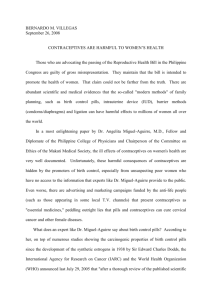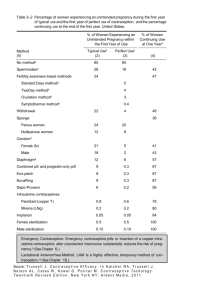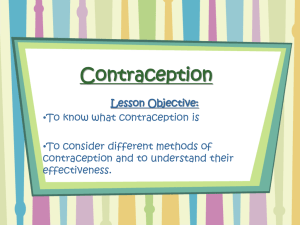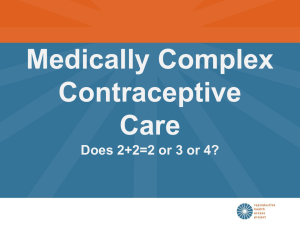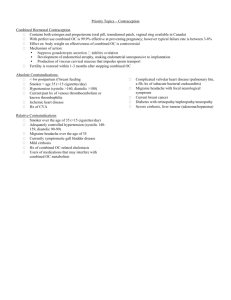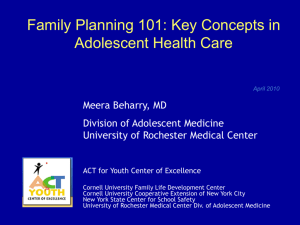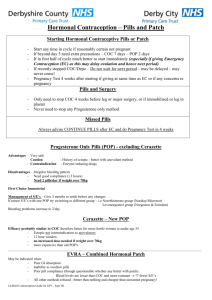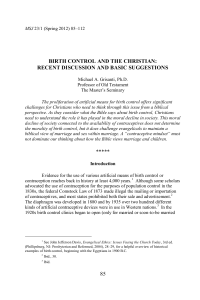Emergency contraception - Life & Liberty Ministries
advertisement
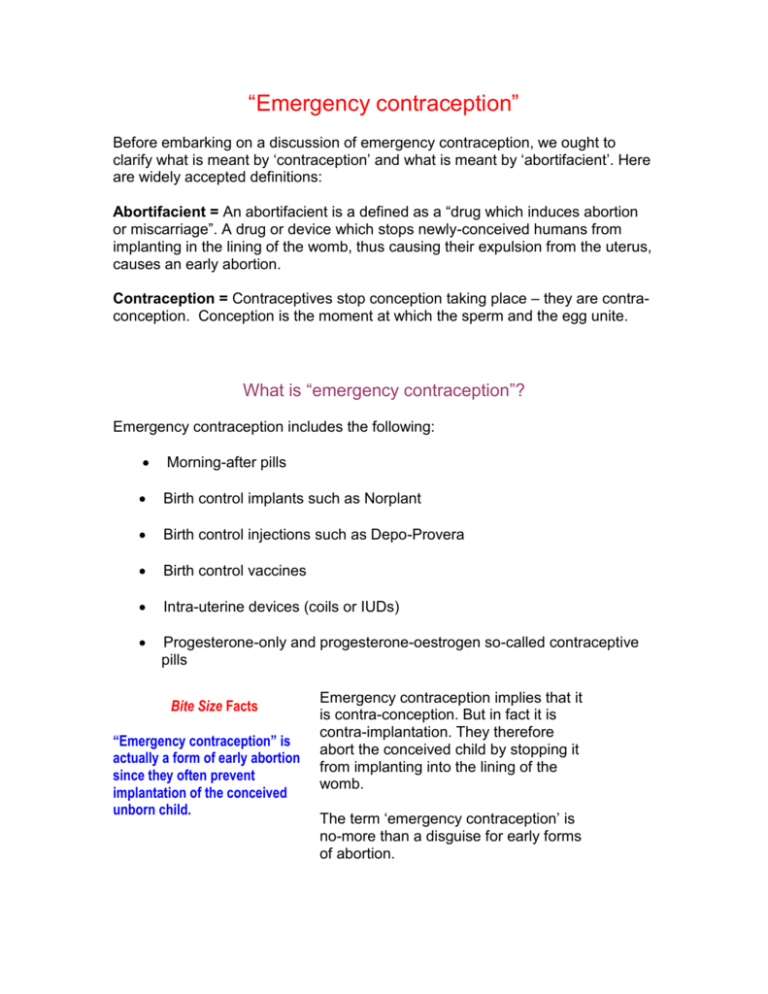
“Emergency contraception” Before embarking on a discussion of emergency contraception, we ought to clarify what is meant by ‘contraception’ and what is meant by ‘abortifacient’. Here are widely accepted definitions: Abortifacient = An abortifacient is a defined as a “drug which induces abortion or miscarriage”. A drug or device which stops newly-conceived humans from implanting in the lining of the womb, thus causing their expulsion from the uterus, causes an early abortion. Contraception = Contraceptives stop conception taking place – they are contraconception. Conception is the moment at which the sperm and the egg unite. What is “emergency contraception”? Emergency contraception includes the following: Morning-after pills Birth control implants such as Norplant Birth control injections such as Depo-Provera Birth control vaccines Intra-uterine devices (coils or IUDs) Progesterone-only and progesterone-oestrogen so-called contraceptive pills Bite Size Facts “Emergency contraception” is actually a form of early abortion since they often prevent implantation of the conceived unborn child. Emergency contraception implies that it is contra-conception. But in fact it is contra-implantation. They therefore abort the conceived child by stopping it from implanting into the lining of the womb. The term ‘emergency contraception’ is no-more than a disguise for early forms of abortion. Bite Size Facts The Department of Health claimed that the morningafter pill is not an abortifacient because pregnancy only starts when an embryo implants in the womb. However, when asked to name three established scientists who accepted that pregnancy only occurred once an embryo had implanted, the Department of Health could not do so. The modern “contraceptive” pill can also act as a form of early abortion The descriptions below highlight how so-called emergency contraception are actually early abortions. The morning-after-pill Bite Size Facts Besides killing the unborn child, the 'modern contracepive pill' often has appalling side-effects on the woman, offering another reason as to why people should not use them. The morning-after-pill (MAP), or post-coital pill can be taken up to 72 hours after unprotected intercourse. The two types of morning after pill which are licensed in the UK are Schering PC-4 and the more commonly used Levonelle-2. Levonelle-2 was made available to over 16 year olds without prescription throughout the UK from 1st January 2001. It is also available to under 16 year olds in some areas, without the parent’s consent or doctor’s knowledge. The morning after pill works by: Preventing or delaying ovulation Thickening the mucus of the cervix which impedes the progress of the sperm Slowing down the tubal transmit time of the ovum by altering the motility of the fallopian tubes And by affecting the lining of the womb (endometrium) so that the embryo cannot implant The first three actions may impede conception, but the fourth is abortifacient. Research has suggested that this is the primary mode of action and Schering the manufacturer of the morning-after-pill, admitted this when it stated that the drug was “primarily aimed to prevent implantation of the fertilised ovum in the endometrium” (Schering, product summary for PC-4 morning-after-pill). The Levonelle-2 morning-after-pill is thought to be more likely to act as an abortifacient since it contains only progestogen. Usage of the morning-after-pill: Use of the morning-after-pill has become very widespread. Nearly a million courses were prescribed to women in 2000. It is also being used amongst very young women. In November 2002 it was discovered that 472 girls as young as 11 had been prescribed the morning-afterpill at schools in Oxfordshire without their parents’ knowledge over the last 5 years (Daily Telegraph, 17 November 02). Dangers to women: The morning-after-pill is extremely strong. Levonelle-2 involves taking 2 tablets which together deliver 50 times the daily dose of 1 contraceptive pill. Morning-after-pills obviously provide no protection against sexually transmitted diseases (STDs) and increased reliance on them could well result in the increase of such diseases. STDs are already spreading fast. For instance between 1995 and 1998, the number of diagnoses of chlamydia in England rose by 28% per year amongst 16 to 19 year old girls. They also contribute to a less responsible approach to sexual activity. People believe they can have sex and just take a pill the next day and they’ll be alright. It encourages a culture of casual sex which can only lead to an increase in STDs and abortions. Because the morning-after-pill can be obtained without prescription, this means young girls can obtain the drug repeatedly. Without prescription, pharmacists cannot check the medical records of the patient to ensure they are not in a highrisk group for taking the morning-after-pill, nor can they ensure that women and girls receive adequate after-care. Thus pharmacists could find themselves legally liable for the outcome of supplying the drug when they have been misinformed. There is also a link between the morning-after-pill and ectopic pregnancies which are a significant cause of rare maternal deaths. Intra-uterine devices An Intra-uterine device (IUD) or coil, is a small, flexible copper device which is put in the uterine cavity and, depending on its type, can stay inside the woman for between three and ten years. An IUD can be fitted within five days of unprotected sex, and in such circumstances, can be misleadingly termed emergency contraception. The copper IUDs release ions into the uterus each day helping to prevent implantation. Other IUDs release progesterone, which also prevents implantation. The Mirena IUD which has been used by about two million women in Europe, releases levonorgestrel into the womb and can remain in the woman’s body for five years. Like morning-after-pills, the IUD can prevent conception on some occasions, but on others be a form of abortion. Usage of the IUD: IUDs are widely used, with an estimated 106 million women fitted with one around the world. Side effects: The IUD can prevent women from having children and so is not recommended for use in young people or those with an allergy to copper. It can cause infection and gives a greater risk of causing an ectopic pregnancy. If the woman has not had any children yet then it can also cause heavy periods and cramps. Therefore not only does it, in some circumstances, kill the unborn child, but it can be a health risk to women. Birth control implants: The Norplant birth control implants are mainly used in developing countries. It consists of six rods which are inserted under the skin of a woman’s upper arm which slowly releases levonorgestrel, a progesterone. Norplant can prevent conception by inhibiting ovulation or thickening cervical mucus, but it also operates as an abortifacient by thinning the endometrium and thereby inhibiting implantation. Ovulation occurs in up to 41% of women with implants, but the drug has an annual observed pregnancy rate of 3.5%. This suggests Norplant is often abortifacient. Side effects of Norplant: The rods can prove difficult to remove, and side-effects include visual impairment, severe headaches and vomiting. Birth control injections: Depo-Provera is an injectable form of synthetic progesterone called medroxyprogesterone acetate, or DMPA. As with Norplant, one of its modes of action is to thin the endometrium to inhibit the embryo’s implantation. Side effects of Depo-Provera: American studies have shown that Depo-Provera is linked to breast cancer. Vaccines: Potentially abortifacient vaccines have also been developed, and have reportedly been used in India and elsewhere. Some of these vaccines manipulate the woman’s immune system so that the sperm, ova or embryos provoke an immune response. Other vaccines are directed against a part of the embryo which later forms the placenta (called the trophoblast). These vaccines cause the embryo to be coated in antibodies and thus unable to implant in his or her mother’s uterus. Oral “contraceptive” pills: Modern contraceptive pills can cause early abortions. Both progesterone-only pills (mini-pills) and progesterone-oestrogen pills can fail to inhibit ovulation. It has been estimated that 40% of women on the progesterone-only pill ovulate at least once a year yet only between five and 10% become pregnant. Assuming these women are having sex regularly, early abortions are probably being caused on a regular basis. The figure is similar for progesterone-oestrogen pills. Modern “contraceptive” pills can also act as forms of early abortion therefore. Sources: SPUC (Publication: A Way of Life – which takes its statistics/research from other sources) as well as Student LifeNet (‘How Morning after pills work’), the Family Planning Act Australia (not a pro-life group) and the Daily Telegraph. Article compiled by Patrick. Contact at Patrick@catholicmission.co.uk
